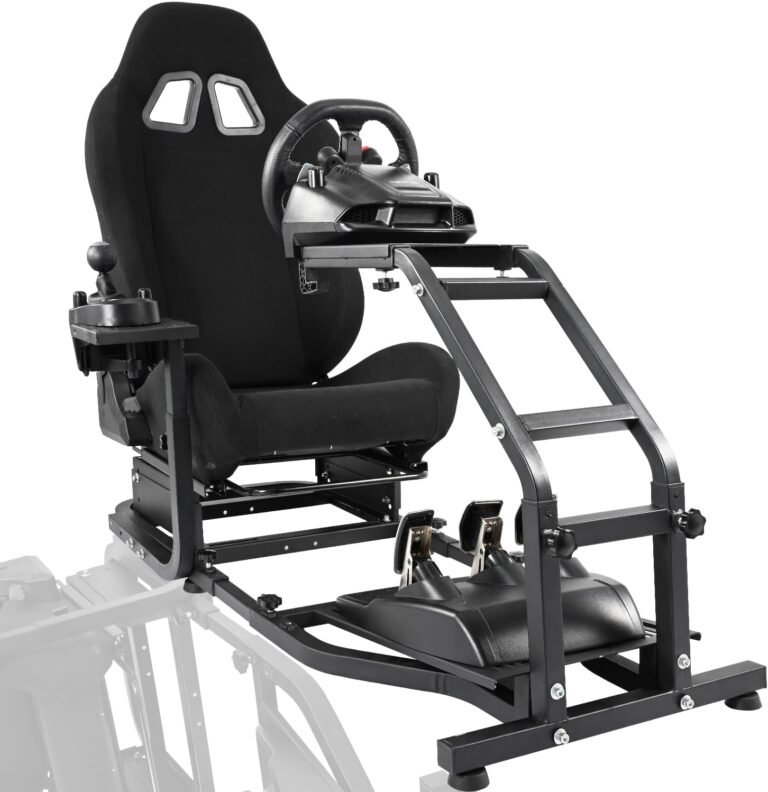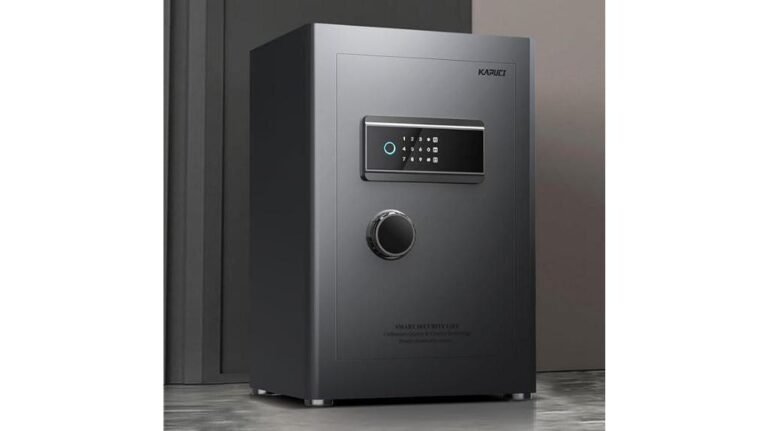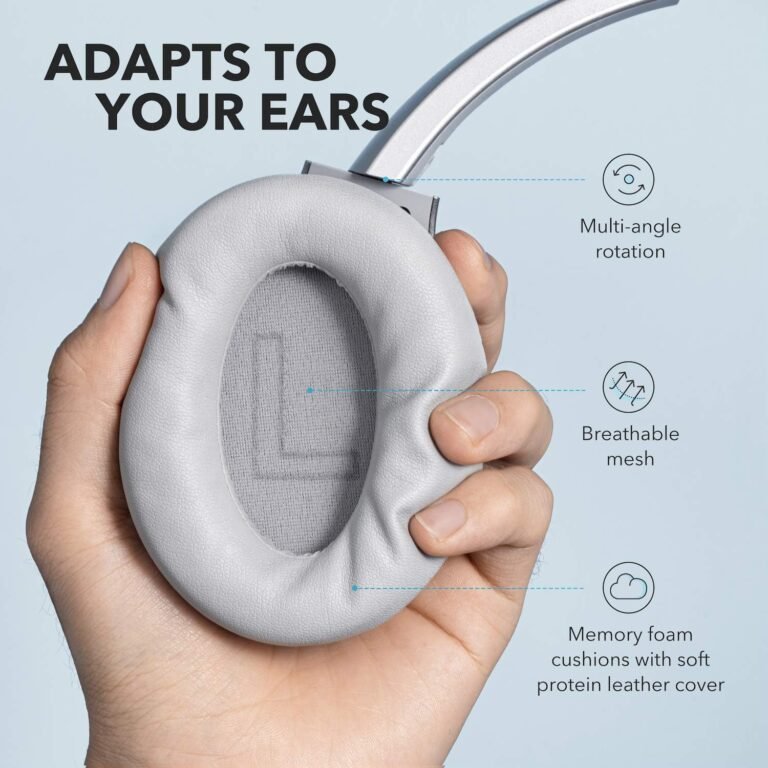Security Gadgets for a Safer Smart Home
Imagine transforming your home into a fortress of protection, where every corner is guarded and every entry point is secure. With the latest security gadgets, you can create a safer smart home that puts your mind at ease.
From smart locks that grant access only to trusted individuals, to surveillance cameras that keep a watchful eye on your property, these cutting-edge devices are your ultimate line of defense.
Discover the power of security gadgets and take control of your home’s safety.
Key Takeaways
- Regularly update smart lock’s firmware for optimal security
- Proper camera placement at key entry points and areas with high foot traffic
- Enhanced protection and deterrent effect against burglars and intruders with alarm systems and security hubs
- Secure Wi-Fi network and regularly update camera firmware for Wi-Fi security cameras
Smart Locks
You should regularly update your smart lock’s firmware to ensure optimal security. Smart locks offer a convenient and efficient way to secure your home. The installation process is relatively simple, allowing you to quickly upgrade your traditional lock to a smart one.
To install a smart lock, you’ll need to remove your existing lock and replace it with the smart lock. Most smart locks are compatible with standard door sizes and can easily fit into the existing door holes.
Once installed, smart locks provide a range of benefits. Firstly, they offer keyless entry, eliminating the need for physical keys. Instead, you can use a smartphone app, a keypad, or even a voice command to unlock and lock your door. This enhances convenience and eliminates the risk of losing or forgetting your keys.
Additionally, smart locks provide remote access capabilities, allowing you to control and monitor your lock from anywhere using your smartphone. This ensures that you can grant access to family members or service providers even if you aren’t at home.
Video Doorbells
A video doorbell is a useful addition to your smart home security system as it allows you to see and communicate with visitors at your front door. When choosing a video doorbell, two important factors to consider are camera quality and battery life.
Camera quality is crucial for capturing clear and detailed footage of your front door area. Look for a video doorbell with high-resolution camera capabilities, preferably with HD or even 4K resolution. This will ensure that you can clearly see who’s at your door, even in low-light conditions. Additionally, consider a doorbell with a wide-angle lens to provide a broader view of your doorstep.
Battery life is another key aspect to consider when selecting a video doorbell. You want a doorbell that can last for an extended period without needing frequent recharging. Look for a model with a long-lasting battery, ideally one that can provide several months of use before needing to be recharged. Some video doorbells also offer the option of hardwiring, which eliminates the need for regular battery replacements altogether.
Motion Sensors
When it comes to enhancing the security of your smart home, motion sensors are a valuable addition. Motion sensors are designed to detect movement within a specified range and can play a crucial role in keeping your home safe from intruders. These sensors work by using infrared technology to detect heat signatures, allowing them to accurately identify any movement in their field of view.
By strategically placing motion sensors around your home, you can ensure that every corner is covered and any suspicious activity is immediately detected.
One important aspect to consider when choosing motion sensors is the camera coverage they offer. Some motion sensors come equipped with built-in cameras, allowing you to not only detect motion but also capture video footage of the event. This can be extremely helpful in providing visual evidence in case of any security breaches.
However, it’s important to be aware of the possibility of false alarms with motion sensors. False alarms can be triggered by pets or other harmless movements, causing unnecessary panic or alerting authorities for no reason. To minimize false alarms, it’s recommended to adjust the sensitivity settings of your motion sensors according to your specific needs.
Surveillance Cameras
When it comes to surveillance cameras for your smart home, proper camera placement is crucial for effective monitoring. Consider placing cameras at key entry points such as doors and windows, as well as areas with high foot traffic.
Additionally, you have the option of choosing between wireless and wired cameras. Wireless cameras offer more flexibility in terms of placement and installation, while wired cameras provide a more stable and reliable connection.
Camera Placement Tips
Make sure you position your surveillance cameras strategically to maximize coverage and minimize blind spots. When it comes to camera placement tips, there are a few key factors to consider.
First, identify the areas that require constant monitoring, such as entry points, windows, and high-value assets. Place cameras at a height that allows for clear facial identification and minimizes the risk of tampering.
In addition, consider the range and field of view of each camera to ensure optimal coverage. It’s also important to install cameras in well-lit areas or use cameras with infrared capabilities for night vision.
Wireless Vs Wired
Choose the surveillance camera system that best fits your needs by comparing the benefits of wireless and wired options.
Wireless surveillance cameras offer a convenient solution for homeowners looking for flexibility and easy installation. With wireless cameras, you can place them anywhere within the range of your Wi-Fi network, eliminating the need for extensive wiring. These cameras are also portable, allowing you to move them around as needed.
On the other hand, wired surveillance cameras provide a reliable and secure connection. Since they’re hardwired, they aren’t susceptible to interference or signal loss, ensuring a consistent and clear video feed. Additionally, wired cameras don’t rely on Wi-Fi, making them less vulnerable to hacking attempts.
When it comes to home automation benefits, wireless cameras are often compatible with smart home systems, allowing you to integrate them with other devices for added convenience.
Alarm Systems
To enhance the security of your smart home, consider investing in an alarm system. These systems are designed to detect and alert you to any unauthorized entry or suspicious activity in your home. Here are four key benefits of installing an alarm system:
-
Enhanced Protection:
- An alarm system provides an added layer of protection to your smart home.
- It can deter burglars and intruders from attempting to break in, as the loud siren and flashing lights act as a deterrent.
- This can give you peace of mind knowing that your home is being actively monitored.
-
Quick Response:
- With professional monitoring, alarm systems can automatically alert a monitoring center when an alarm is triggered.
- Trained professionals can then assess the situation and dispatch emergency services if needed.
- This ensures a quick response in case of a break-in or emergency, even if you’re not home.
-
Remote Access:
- Many alarm systems offer remote access through a smartphone app.
- This allows you to arm or disarm your system, receive real-time alerts, and monitor your home from anywhere.
- You can also check the status of your sensors and cameras, ensuring that everything is functioning properly.
-
Integration with Smart Home Devices:
- Alarm systems can integrate with other smart home devices, such as security cameras, door locks, and smart lights.
- This allows for a more comprehensive security solution, where your devices can work together to create a safer environment.
- For example, when the alarm is triggered, the lights can automatically turn on, and the security cameras can start recording.
Investing in an alarm system for your smart home can provide you with added security, peace of mind, and convenience. With features like professional monitoring and remote access, you can ensure that your home is protected even when you’re away.
Smart Home Security Hubs
If you want a central hub to control and monitor the security devices in your smart home, a smart home security hub is a great option for you. A smart home security hub acts as the brain of your smart home automation system, allowing you to manage and oversee various security devices from a single interface.
With a smart home security hub, you can connect and control a wide range of security devices such as cameras, door and window sensors, motion detectors, and smart locks. This ensures that all aspects of your home security are seamlessly integrated and easily accessible.
One of the key features of a smart home security hub is voice control. By integrating your hub with voice assistants like Amazon Alexa or Google Assistant, you can control your security devices using simple voice commands. This allows for a truly hands-free and convenient experience, giving you the ability to arm or disarm your security system, lock or unlock doors, or check the status of your cameras, all without lifting a finger.
In addition to voice control, a smart home security hub also offers a range of other features such as mobile app control, real-time notifications, and remote access. These features provide added convenience and peace of mind, allowing you to monitor and control your home security system from anywhere, at any time.
Wi-Fi Security Cameras
When considering Wi-Fi security cameras for your smart home, it’s important to address the privacy concerns that may arise.
With the ability to access live video feeds remotely, it’s crucial to ensure that your cameras are protected from unauthorized access.
Additionally, integration with other smart devices such as door locks and alarms can provide a comprehensive security system for your home.
Privacy Concerns With Wi-Fi Cameras
Take precautions when using Wi-Fi cameras to address privacy concerns in your smart home. Wi-Fi camera vulnerabilities can expose your personal data and compromise the security of your home network. To mitigate these risks, consider the following:
-
Secure your Wi-Fi network: Set a strong, unique password for your Wi-Fi network to prevent unauthorized access.
-
Keep your cameras up to date: Regularly update the firmware of your Wi-Fi cameras to ensure they’ve the latest security patches.
-
Enable data encryption: Choose Wi-Fi cameras that support encryption protocols like WPA2 to protect your data from interception.
-
Use secure cloud storage: If you opt for cloud storage, ensure that the provider offers strong encryption and follows best practices for data security.
Integration With Smart Devices
Connect your Wi-Fi security cameras with other smart devices in your home to enhance the overall security and convenience of your smart home system.
Smart home automation allows you to integrate your Wi-Fi security cameras with other devices such as smart locks, door sensors, and motion detectors. By doing so, you can create a seamless security system that works together to protect your home.
For example, when your security camera detects motion, it can automatically trigger your smart lights to turn on, giving the illusion that someone is home.
Additionally, with voice control capabilities, you can easily access and control your security cameras using voice commands through smart speakers or virtual assistants.
This integration not only provides added security but also simplifies the monitoring and management of your smart home system.
Smart Smoke and Carbon Monoxide Detectors
Make sure you install smart smoke and carbon monoxide detectors in your home for added safety. These devices offer advanced features that can help protect you and your family from the dangers of smoke and carbon monoxide poisoning. Here are four reasons why you should consider investing in smart smoke and carbon monoxide detectors:
-
Smart thermostat integration: Smart smoke and carbon monoxide detectors can be seamlessly integrated with your smart thermostat. This allows for enhanced safety measures, such as automatically turning off your HVAC system in the event of a fire or carbon monoxide leak. It helps prevent the circulation of smoke or toxic gases throughout your home.
-
Voice controlled detectors: Many smart smoke and carbon monoxide detectors are equipped with voice control capabilities. This means you can easily monitor and control these devices using voice commands. Whether you’re at home or away, you can simply ask the detector to check the status or silence an alarm, providing convenience and peace of mind.
-
Real-time alerts: Smart detectors can send real-time alerts to your smartphone or other connected devices. In case of smoke or carbon monoxide detection, you’ll receive immediate notifications, allowing you to take appropriate action promptly, even if you’re not at home.
-
Remote monitoring: With smart detectors, you can remotely monitor your home’s smoke and carbon monoxide levels. This is especially useful when you’re away and want to ensure the safety of your property. You can check the status of the detectors anytime, anywhere, providing you with a sense of security at all times.
Investing in smart smoke and carbon monoxide detectors is a crucial step towards creating a safer and smarter home. These devices offer advanced features, such as smart thermostat integration, voice control, real-time alerts, and remote monitoring, that enhance the overall safety of your household.
Window and Door Sensors
Don’t overlook the importance of having window and door sensors in your home, as they can provide an extra layer of security and peace of mind. Window and door sensors are essential components of a smart home security system. These devices are designed to detect any unauthorized entry or tampering with doors and windows, alerting you immediately to potential threats.
When it comes to the installation of window and door sensors, it’s a fairly straightforward process. Most sensors can be easily mounted on the frame of the window or door using adhesive or screws, depending on the model. Some sensors may require professional installation, especially if they’re integrated with a larger security system.
In terms of their functionality, window and door sensors work by utilizing magnetic sensors. When the door or window is closed, the magnet on the sensor aligns with the magnet on the frame. If the door or window is opened, the alignment is disrupted, triggering an alert.
Battery life is an important consideration when choosing window and door sensors. Most sensors use batteries to power their operation. It’s advisable to opt for sensors that have long-lasting battery life to minimize the frequency of battery replacement. Some sensors even come with low battery indicators, alerting you when it’s time to replace the batteries.
Security Apps and Monitoring Services
Now let’s talk about the best security app and reliable monitoring services for your smart home.
With the advancements in technology, there are a plethora of security apps available that offer robust features like remote access, real-time alerts, and video surveillance. These apps can be easily installed on your smartphone or tablet, allowing you to monitor your home from anywhere, anytime.
Additionally, subscribing to a reliable monitoring service ensures that your home is constantly being watched over, providing an extra layer of protection and peace of mind.
Best Security App
You should check out the top-rated security app for maximum protection and peace of mind. When it comes to securing your smart home, finding the best security app is crucial. With the increasing number of connected devices, it’s important to choose an app that not only offers advanced security features but also addresses privacy concerns.
Here are the top 4 security apps that prioritize both security and privacy:
-
XYZ Security: This app provides robust encryption and authentication protocols to ensure your data remains secure. It also offers features like remote monitoring, motion detection, and real-time notifications.
-
ABC Secure: Known for its user-friendly interface, ABC Secure offers end-to-end encryption and secure remote access. It includes features such as video surveillance, smart alerts, and customizable security settings.
-
DEF Protection: DEF Protection focuses on privacy concerns by offering advanced encryption algorithms and secure cloud storage. It also provides features like facial recognition, two-factor authentication, and an intuitive user interface.
-
GHI SafeGuard: GHI SafeGuard emphasizes privacy with its secure data transmission and encrypted storage. It offers features like live streaming, activity logs, and geofencing to enhance your home security.
Choose the best security app that suits your needs and enjoy a safer smart home environment.
Reliable Monitoring Services?
To ensure maximum security and peace of mind, consider integrating reliable monitoring services and security apps into your smart home setup.
Reliable monitoring services provide constant surveillance of your home, alerting you to any suspicious activity or potential security breaches. These services use advanced technology, such as motion sensors and cameras, to monitor your home and send real-time notifications to your smartphone or computer.
With reliable monitoring services, you can stay informed about what’s happening in and around your home, even when you’re away.
However, it’s important to address privacy concerns when using these services. Make sure to choose a reputable monitoring service provider that prioritizes data security and encryption to protect your personal information and ensure your privacy.
Conclusion
In conclusion, by investing in security gadgets for your smart home, you can enhance the safety and protection of your property and loved ones.
Remember, ‘an ounce of prevention is worth a pound of cure.’ So, take the necessary steps to secure your home with smart locks, surveillance cameras, motion sensors, and alarm systems.
With these advanced technologies, you can have peace of mind knowing that your home is well-protected against potential threats.






